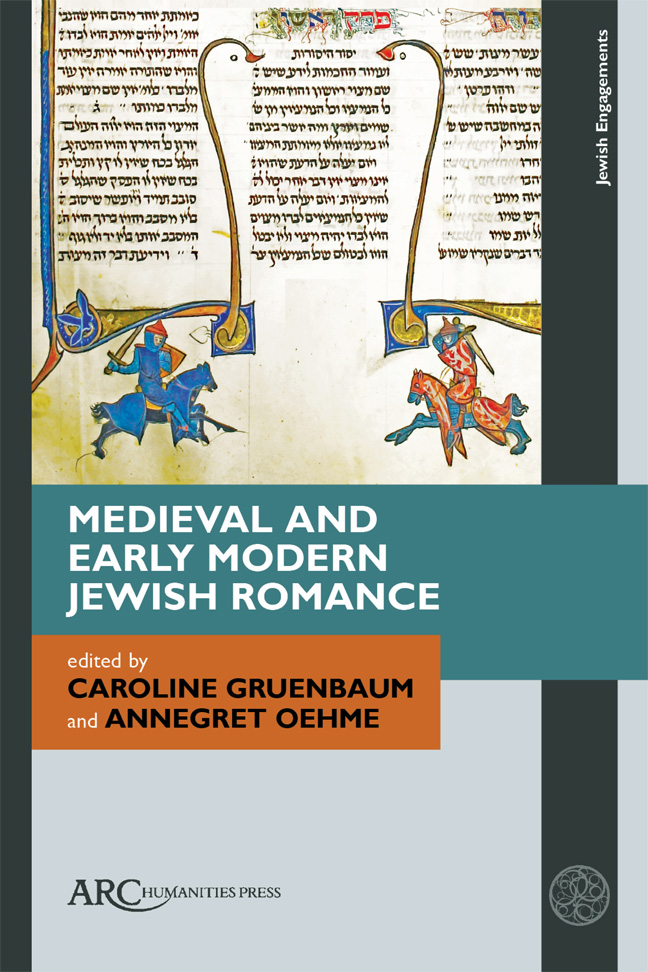Book contents
- Frontmatter
- Dedication
- Contents
- List of Illustrations
- Acknowledgements
- Introduction
- The Zohar as Medieval Jewish Romance
- Letters of Loathing: Immanuel of Rome and Romance Epistolary
- Illuminated Knights and Tales of Romance in the Rothschild Miscellany
- The Queen Nudatio: A Romanesque (?) Topos in Israel Caslari's Roman d’Esther
- At the Court of the Demon King: The Story of the Jerusalemite and Chivalric Romance
- Melekh Artus as a Jewish Romance: Horizons of Expectation and Genre Configurations
- A Friend in Need is a Friend Indeed?Friendship, Love, and Loyalty in the Yiddish Seven Sages of Rome
- Stealing Back One's Husband: The Yiddish Mayse mi-Danzek in the Context of Early Modern German Cross-Dressing Narratives
- Romance Elements in Meshal Haqadmoni by Isaac Ibn Sahula: A New Reading
- Afterword: Jewish Romance in Search of Identity
- Select Bibliography
- Index
The Queen Nudatio: A Romanesque (?) Topos in Israel Caslari's Roman d’Esther
Published online by Cambridge University Press: 18 February 2024
- Frontmatter
- Dedication
- Contents
- List of Illustrations
- Acknowledgements
- Introduction
- The Zohar as Medieval Jewish Romance
- Letters of Loathing: Immanuel of Rome and Romance Epistolary
- Illuminated Knights and Tales of Romance in the Rothschild Miscellany
- The Queen Nudatio: A Romanesque (?) Topos in Israel Caslari's Roman d’Esther
- At the Court of the Demon King: The Story of the Jerusalemite and Chivalric Romance
- Melekh Artus as a Jewish Romance: Horizons of Expectation and Genre Configurations
- A Friend in Need is a Friend Indeed?Friendship, Love, and Loyalty in the Yiddish Seven Sages of Rome
- Stealing Back One's Husband: The Yiddish Mayse mi-Danzek in the Context of Early Modern German Cross-Dressing Narratives
- Romance Elements in Meshal Haqadmoni by Isaac Ibn Sahula: A New Reading
- Afterword: Jewish Romance in Search of Identity
- Select Bibliography
- Index
Summary
מון רומאן ווייל אקומנשאר
I wish to begin my tale
THESE ARE THE words with which Israel ben Joseph Caslari, a Jewish physician, begins his original Judeo-French adaptation of the biblical book of Esther (composed ca. 1327). Drawing heavily on the author's own creative imagination this roman is based on the rabbinic narrative literature related to the books of Esther and Daniel. Israel Caslari uses the term roman, which originally referred to the Romance—that is Latin-descended—languages, to refer to a literary récit, an entertaining story told to amuse and/or educate and often rhetorically claimed to be truthful. By the time Israel composed his work in the early fourteenth century in southern France, the term had come to signify, in both the northern and southern French languages, a literary work independent of the language in which it was composed. While in hindsight, it can be claimed that Spanish and Italian romances remained “romances in Romance,” romances were also being composed, or translated/adapted, in German and English. Jewish writers, simultaneously inspired by this rich variety of romances and by the Arabic maqama, were also writing imaginative stories, dramas and comedies about love and chivalric adventures. As these works were in Hebrew, they were clearly addressing the Jewish communities, and though some were not particularly Jewish in content, at present all are referred to as “Jewish romances.” Israel Caslari's work is of particular interest in this context, as it is not merely a thematic Jewish romance (a comical rendition of the Book of Esther in the spirit of Purim), it is also a Jewish romance written in a Jewish Romance language, the Judeo-Provençal language that is transcribed with Hebrew characters.
At the time that Israel's tale takes place, King Nebuchadnezzar, who appears only briefly at the beginning of the book of Esther, had erected a statue in his own image and ordered all of his subjects to prostrate themselves in front of it, under the penalty of decapitation.
- Type
- Chapter
- Information
- Medieval and Early Modern Jewish Romance , pp. 73 - 94Publisher: Amsterdam University PressPrint publication year: 2023



